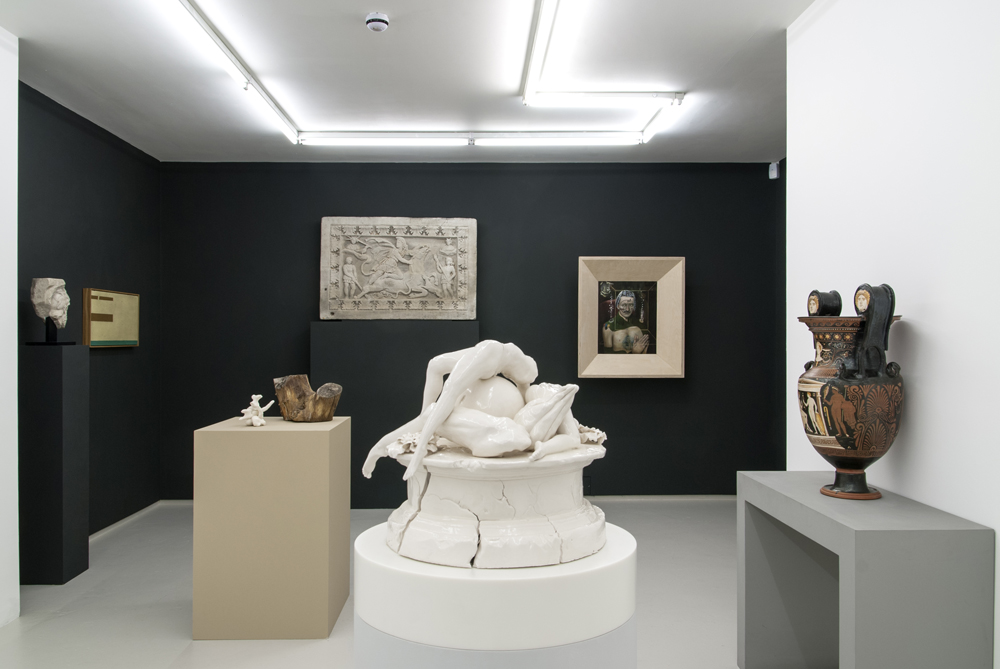


CLASSICICITY - Installation View, Breese Little, March 2015. Courtesy Breese Little, London. Photography Tom Horak (1)
Nell Allen, Edward Allington, Maggi Hambling, Richard Hawkins, Rachel Kneebone, Tory Lawrence, Sarah Lucas, Ged Quinn, Ryan M Pfeiffer + Rebecca Walz, Mary Reid Kelley and Alexandre Singh
Back in 1990, the Tate mounted an exhibition called On Classic Ground that looked at a brief moment in the interwar years when European artists such as Picasso and Leger retreated stylistically from some of the extremes of the avant-garde and looked to classical precedents. In the work of ancient Greek and Roman artists they found a sense of timelessness and a humanity that was all the more welcome after the Europe-wide traumas of the First World War.
Twenty five years later, the act of recuperating, or re-examining the art of the past locates in an entirely different context. We live in a world where it is possible to summon up fragments of culture high and low, in seconds, on your phone. The whole of history is arguably up for grabs. Artists have been availing themselves of this possibility for some years – liberated from the laboriously literal cut and paste of previous times, visual collage can be three dimensional or digital, or even both in the case of Oliver Laric’s 3D scanning. So what does it mean to quote from the Classical world now?
The artists in the latest group show at Breese Little have not been chosen for their polite allusions to a rarefied and refined version of the classical. Instead they celebrate a frank sexuality and eroticism that brings to mind the phallic talismans that hung at the door of houses in Pompeii. So we have Sarah Lucas’ Penetralia, 2008, for example, which I confess is one of my favourite works of the last decade, in which a plaster finger balanced on a little pile of plaster vertebrae, or flints, gestures lewdly at a log, bifurcated suggestively; the white of the plaster carries its own classical allusion, as does the apparent purity of Rachel Kneebone’s white ceramics. Closer inspection reveals heaped and splayed female torsos, arranged like so many fruit in a bowl, or in another work upstairs, a jolly little carnival of animated phalluses cavorting with lascivious tongues.
Alexandre Singh’s two photographic works also reference the tradition of classical statuary: heavily powdered figures in Roman costume literally bring to life the story of Pygmalion, stepping down from the plinth in the process of changing from cold stone sculpture to living being.
Minotaurs also abound in the show – linking us to the classical past via the Surrealists whose fascination with early psychiatry made the Minotaur the perfect metaphor for the beast lurking in our subconscious. Presiding over the whole exhibition is a quarter or a ton stone relief of Mithras sacrificing a bull. Dated 2nd century AD it is a bloodthirsty and compelling image of a rite at the heart of the Mithras cult. Maggi Hambling and Mary Reid Kelley both picture minotaurs in their paintings, and the cultish-looking Ged Quinn painting included here also offers a glimpse of the mythical monster. Quinn’s painting is extravagantly deeply framed, like a Hopper drawing you in. Its multi-layered symbolism requires time, and perhaps a glossary to decode in much the way Salvador Dali’s more elaborate paintings need. The figure’s head is draped in a turban of 35mm film, streams of bubbles rise from each shoulder, the bared chest is tattooed with a pensive female bust and the figure’s face is inscribed with the word ri-di-cule in a way that instantly recalls the over-excited word play in English of the surrealists newly arrived in New York in the 1930s (think of Picabia’s LHOOQ).
Installed in counterpoint to some very lovely examples of classical sculpture, there is a great deal to enjoy in this amiably saucy and thoughtful show, curated by Ruth Allen and James Cahill, both currently researching PhDs at Cambridge University. Something for the weekend?
Caroline Douglas
Director
Breese Little, 30b Great Sutton Street, London EC1V ODU. Open Wednesday - Friday 12.00 - 18.00, Saturday 12.00-16.00. Exhibition continues until 2 April 2015. www.breeselittle.com